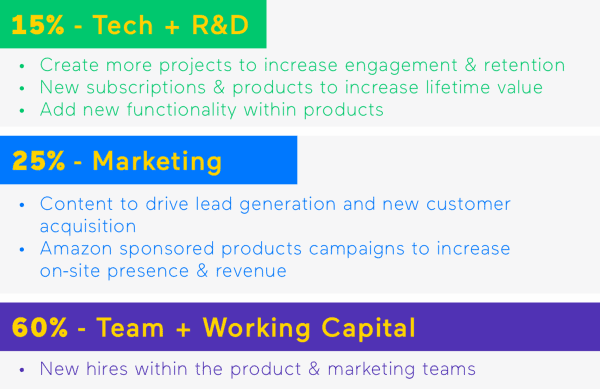This
afternoon the federal government printed the long-awaited particulars of the Future Fund,
and the appliance portal for match funding purposes will open on
Wednesday. You’ll be able to see an outline right here,
investor-specific data and FAQs right here and
company-specific data and FAQs right here.
If
you have an interest in elevating your non-public match funding for the Future Fund
via Seedrs, please get in contact. If you have already got a contact at Seedrs,
you may e mail them straight, or else please drop a line to campaigns@seedrs.com.
At this time’s
announcement comes after practically a month of intense work to flesh out and
operationalise this initiative, which the Chancellor first introduced on 20
April. A number of the outcomes are optimistic, some much less so, and I’m acutely aware that
for the reason that preliminary announcement, many individuals have expressed legitimate issues about
the eligibility standards, phrases and far else. However whereas this isn’t excellent, I
proceed to take the view that, on stability, it’s a improbable and much-needed
contribution to the startup and scaleup ecosystem throughout this time of disaster.
I’ve
written beforehand about the necessity for this type of
package deal and reactions to the preliminary
announcement. I gained’t repeat these right here, nor will I am going into the entire particulars
launched right this moment as they’re obtainable on the Future Fund
part
of the British Enterprise Financial institution web site. As an alternative, I need to use this chance
share ideas on a number of of the important thing options of the Future Fund and what I feel
they’ll imply for companies and buyers.
First-Come,
First-Served
The
Future Fund will probably be distributed on a purely first-come, first-served foundation. As
corporations elevate the required match funding, they (or, particularly, their lead
buyers) will be capable of apply to the Future Fund via the web portal.
Assuming all eligibility standards are met, the Future Fund will then allocate
funding primarily based on the order wherein the appliance was obtained or processed
(it’s not but clear which).
There
had been some hypothesis that the distribution course of may be extra nuanced,
with particular swimming pools put aside for smaller or regional corporations. The choice
not to take action was presumably taken within the curiosity of simplicity and effectivity,
however it does create a number of dangers. One is that the £250 million pot allotted to
the Future Fund will get deployed in a short time: on condition that the fund will match up
to £5 million per firm, it gained’t take a complete lot of purposes from
companies which have raised substantial matching capital earlier than all the federal government’s
cash is spent. As a corollary to this, and maybe extra worryingly, bigger
corporations with established investor bases are probably to have the ability to transfer quicker
than smaller ones, which means that we may even see the majority of the Future Fund
allotted to VC-backed, London-based companies slightly than unfold throughout sector,
stage and placement.
How
this performs out will all rely upon whether or not extra money is made obtainable to the
Future Fund as soon as the preliminary £250 million has been spent. Authorities clearly
desires to keep away from one other state of affairs like CBILS, the place an enormous sum of money was
nominally made obtainable, however then the method of getting it out the door was
gradual and restrictive. In order that they have arrange a system right here that can maximise the
pace with which funds are deployed, and in doing so that they have made noises to
the impact (and the Chancellor confirmed within the Commons right this moment) that if demand
is adequate, extra money will probably be launched.
As
lengthy as that really occurs, then the first-come, first-served method
ought to work high-quality. The extra subtle companies will nonetheless in all probability be the
first to entry the cash, but when there’s then sufficient within the (expanded) pot to
meet the wants of corporations who take a bit longer to boost their non-public
funding and submit their software, then I feel the substantive issues are
largely addressed.
Broad
Investor Eligibility
I
wrote in my piece on “Leaving the Tower” a number of weeks in the past
about how there have been some voices arguing for tight restrictions on who may
present the non-public match funding. The specious, and I feel self-interested,
arguments successfully stated that solely established VCs ought to be capable of present
the match, as a result of in any other case the Future Fund would threat following “dumb” cash.
Fortuitously
Treasury paid these arguments no extra heed than they have been due and as an alternative opted
for a really broad definition of who will be an eligible investor. Basically any
self-certified high-net-worth or subtle investor will probably be eligible, as
will funding professionals (which incorporates primarily all FCA-authorised
companies, amongst others) and related classes. And this is applicable not simply to
buyers who meet the UK definitions of those phrases but additionally these
worldwide buyers who fulfill the equal dwelling nation requirements.
This
is an excellent consequence, and the inclusion particularly of high-net-worth and
subtle buyers goes to be essential for a spread of corporations that
depend on particular person buyers, particularly these which are too early for VC
funding and people from exterior London. And observe that when you elevate capital
via an funding agency, comparable to Seedrs, that makes the investments on the
buyers’ behalf, buyers don’t even want to fulfill the high-net-worth or
subtle exams as long as they fulfill the agency’s consumer onboarding
necessities.
No
EIS
A
much less encouraging improvement was the ultimate dedication that the non-public match
funding is not going to be eligible for EIS aid. It was recognized that this was a
probably consequence on the time of the preliminary announcement final month: the Future
Fund’s investments will probably be by means of convertible mortgage observe (CLN), and CLNs are
not EIS-eligible; so if the federal government was going to require the non-public match
funding to be on the very same phrases because the Future Fund’s funding, the
non-public funding wouldn’t be eligible both.
A considerable quantity of labor went on behind the scenes with a view to attempt to repair this concern. There was speak of permitting non-public buyers to take a position through an Superior Subscription Settlement (ASA), which is sort of a CLN however lacks the debt-like options that make CLNs ineligible. This was rejected on the premise that the federal government wished the phrases to match precisely between the Future Fund and personal buyers. My very own view is that this might have labored simply high-quality—not least as a result of the ASA would have been barely much less advantageous to buyers than the CLN, so the Future Fund would have gotten the higher finish of the deal—however I feel a mixture of guaranteeing effectivity and a scarcity of familiarity with ASAs prevented this concept from going ahead (Seedrs does ASAs fairly continuously, however there are some who view them as nonetheless a primarily American instrument). There was additionally dialogue of a rule change to permit CLNs—or no less than these used particularly for this match funding course of—to draw EIS aid, however the attorneys concluded that such a change would violate EU state assist guidelines.
So
buyers is not going to get EIS aid, and this can little doubt postpone a few of the
particular person buyers, in addition to VCTs and EIS funds, who may in any other case have
wished to place up the match funding (VCs and lots of different funds are usually not eligible
for EIS, so it is not going to have an effect on them). I’m barely much less bothered by this than
many individuals are, as I feel that whereas EIS is a improbable scheme that advantages
UK startups and scaleups vastly, investing in a portfolio of early-stage
companies must be a high-returning endeavour even with out tax aid. Intelligent
buyers will hopefully really feel that the chance to spend money on good companies
on what are comparatively investor-friendly phrases—and in doing so take benefit
of presidency leverage within the type of match funding—offsets the shortage of EIS.
However I’m acutely aware that some buyers will really feel in a different way, and once more that is
largely more likely to be to the detriment of smaller and regional companies.
There
is a separate, difficult level round whether or not investing in a CLN may consequence
in buyers shedding EIS on earlier or future investments they’ve made or
will make within the firm. This was a big concern, however it has been
partially resolved within the FAQs which make it clear that there will probably be no impression
on aid in respect of earlier investments. The FAQs are, nonetheless, silent on
future investments, saying merely it is a matter for HMRC. Hopefully HMRC
will make clear that quickly, however no less than the problem for earlier investments has been
taken off the desk.
Investor-Led
Course of
Lastly,
I believed it noteworthy that the appliance for Future Fund funding will
want to come back from the lead investor of the non-public match funding, slightly than
from the corporate. There will not be a complete lot on this, however at first look it
appears a bit odd: usually it’s the firm that has a lot of the crucial
data to course of investment-related documentation, and whereas an
institutional lead investor will probably have programs in place that make this
course of straightforward, it could show cumbersome—and even error-prone—for buyers who
are usually not as targeted on the technical particulars of execution. In follow I might anticipate
any wise firm to work along with their lead investor to make sure that
the method goes easily, however this method does appear to be a hurdle that
doesn’t add a lot actual worth.
One profit that not directly pertains to this course of (however may have occurred even when purposes have been company-led) is that buyers are being requested to signal the Investing in Girls Code. I feel it is a superb initiative: the challenges that girls founders face in elevating capital are well-publicised, and this Code will assist present transparency and corrective motion to assist be certain that the highest-potential entrepreneurs reach elevating capital no matter gender. Examine Warner of Ada Ventures has written an glorious piece about how this Code and different measures can assist be certain that the Future Fund is allotted throughout numerous companies and groups. (I’ll confess that I used to be not conscious of the Code till studying about it within the context of the Future Fund, however after discussing with and receiving unanimous assist from our Government Crew, I’ve now signed it on behalf of Seedrs).
Last
Ideas
The
Covid-19 disaster is an uncommon one: not like the dot-com bust and even, to an
extent, the 2007-2009 monetary disaster, this isn’t a interval the place dried-up
funding streams and massively diminished valuations characterize a standard and
crucial market correction following a interval of overexuberance. Right here we’ve got
a startup and scaleup ecosystem that was thriving however not (with the exception
of a handful of corporations) a bubble, and most of those companies are effectively
poised to proceed their development as soon as the economic system re-opens.
However
within the short-term, many companies whose technique is to spend money on development slightly
than reap early income, and who run lean on money within the course of, are going to
face important challenges. In the meantime, non-public sector funding is inherently
going to say no as buyers—each institutional and particular person—look to sit on money whereas uncertainty
prevails. The Future Fund supplies a important answer to assist deliver capital
into the market and be certain that all of the work we’ve got accomplished over the previous decade
to construct this ecosystem will not be misplaced throughout this era.
No construction or method to offering this capital was ever going to be excellent, however as we now see extra of the small print on how the Future Fund will work, I’m more and more assured that it will likely be successful. As I focus on above, a number of issues should be true: there definitely must be extra funding if (and when) the £250 million is rapidly deployed; and even when EIS isn’t obtainable on this funding, it must be clarified that investing in a CLN is not going to prejudice future EIS aid. However as long as these two issues occur, I feel that given the broad investor eligibility, the streamlined (if barely peculiar) software course of, and a distribution system that prioritises pace and effectivity, this initiative goes to be a win for the federal government and, extra importantly, a win for a lot of startups and scaleups throughout the nation.
***
That’s all from me this week. As soon as once more, please get in contact if you want to debate elevating a CLN through Seedrs – you may e mail campaigns@seedrs.com, your Seedrs contact or me at anytime. As at all times please let me know when you’ve got suggestions or contributions, and I hope you all keep effectively and protected within the week forward.
—
Jeff Lynn
I am Government Chairman and Co-Founding father of Seedrs.





